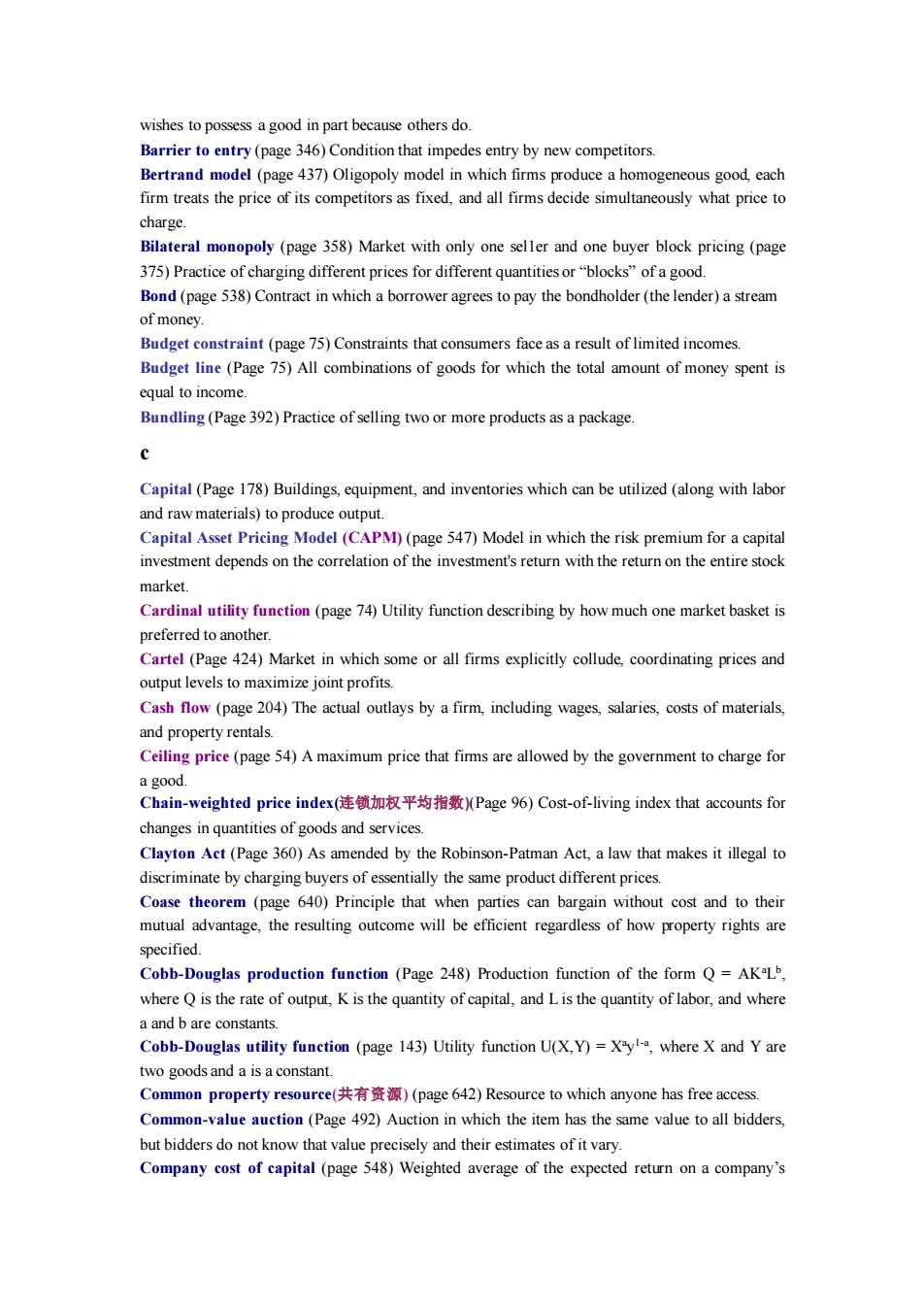正在加载图片...

wishes to possess a good in part because others do. Barrier to(page 6)Condition that impedes entry by new competitor Bertrand model (page 437)Oligopoly model in which firms produce a homogeneous goodea firm treats the price of its competitors as fixed,and all firms decide simultaneously what price to charge. Bilateral monopoly (page 358)Market with only one seller and one buyer block pricing (page Bond(page538)Contract in whicha borrower agrees topay the bondholder (the lender)astream of money Budget constraint (page 75)Constraints that consumers face as a result of limited incomes. Budget line(Page 75)All combinations of goods for which the total amount of money spent is equal to income. Bunding(Page 39)Practice of selling twoor more products as a package Capital (Page 178)Buildings,equipment,and inventories which can be utilized(along with labor and raw materials)to produce output. Capital Asset Pricing Model (CAPM)(p ge 547)Model in which the risk prer mium for a capital tment deper on the the investment's retu with the the entire market. Cardinal utility function(page 74)Utility function describing by how much one market basket is preferred to another. Cartel (Page 424)Market in which s omeor all firms explicitly collude coordinating pices and Jont profits. Cash flow (page 204)The actual outlays by a firm,including wages,salaries,costs of materials, and property rentals. Ceiling price (page 54)A maximum price that firms are allowed by the government to charge for a good. Chain-weighted price index(连锁加权平均指数(Page96)Cost-of-living index that for changes in quantities of goods and services Clayton Act (Page 360)As amended by the Robinson-Patman Act,a law that makes it illegal to discriminate by charging buyers of essentially the same product different prices. Coase theorem (page 640)Principle that when parties can bargain without cost and to their mutual advantage.the resulting outcome will be efficient regardless of how property rights are Cobb-Douglas production function (Page 248)Production function of the formQ-AKL whereQ is the rate of output,K is the quantity of capital,and Lis the quantity of labor,and where a and b are constants Cobb-Douglas utility function (page 143)Utility function U(X.Y)X where X and Y are two goods and a is constant Common property resource(共有资a源)(page642)Resource to which anyone has free acces Common-value auction (Page 492)Auction in which the item has the same value to all bidders but bidders do not know that value precisely and their estimates of it vary. Company cost of capital (page 548)Weighted average of the expected return on a company's wishes to possess a good in part because others do. Barrier to entry (page 346) Condition that impedes entry by new competitors. Bertrand model (page 437) Oligopoly model in which firms produce a homogeneous good, each firm treats the price of its competitors as fixed, and all firms decide simultaneously what price to charge. Bilateral monopoly (page 358) Market with only one sel1er and one buyer block pricing (page 375) Practice of charging different prices for different quantities or “blocks” of a good. Bond (page 538) Contract in which a borrower agrees to pay the bondholder (the lender) a stream of money. Budget constraint (page 75) Constraints that consumers face as a result of limited incomes. Budget line (Page 75) All combinations of goods for which the total amount of money spent is equal to income. Bundling (Page 392) Practice of selling two or more products as a package. c Capital (Page 178) Buildings, equipment, and inventories which can be utilized (along with labor and raw materials) to produce output. Capital Asset Pricing Model (CAPM) (page 547) Model in which the risk premium for a capital investment depends on the correlation of the investment's return with the return on the entire stock market. Cardinal utility function (page 74) Utility function describing by how much one market basket is preferred to another. Cartel (Page 424) Market in which some or all firms explicitly collude, coordinating prices and output levels to maximize joint profits. Cash flow (page 204) The actual outlays by a firm, including wages, salaries, costs of materials, and property rentals. Ceiling price (page 54) A maximum price that firms are allowed by the government to charge for a good. Chain-weighted price index(连锁加权平均指数)(Page 96) Cost-of-living index that accounts for changes in quantities of goods and services. Clayton Act (Page 360) As amended by the Robinson-Patman Act, a law that makes it illegal to discriminate by charging buyers of essentially the same product different prices. Coase theorem (page 640) Principle that when parties can bargain without cost and to their mutual advantage, the resulting outcome will be efficient regardless of how property rights are specified. Cobb-Douglas production function (Page 248) Production function of the form Q = AKaL b , where Q is the rate of output, K is the quantity of capital, and L is the quantity of labor, and where a and b are constants. Cobb-Douglas utility function (page 143) Utility function U(X,Y) = Xay 1-a , where X and Y are two goods and a is a constant. Common property resource(共有资源) (page 642) Resource to which anyone has free access. Common-value auction (Page 492) Auction in which the item has the same value to all bidders, but bidders do not know that value precisely and their estimates of it vary. Company cost of capital (page 548) Weighted average of the expected return on a company’s